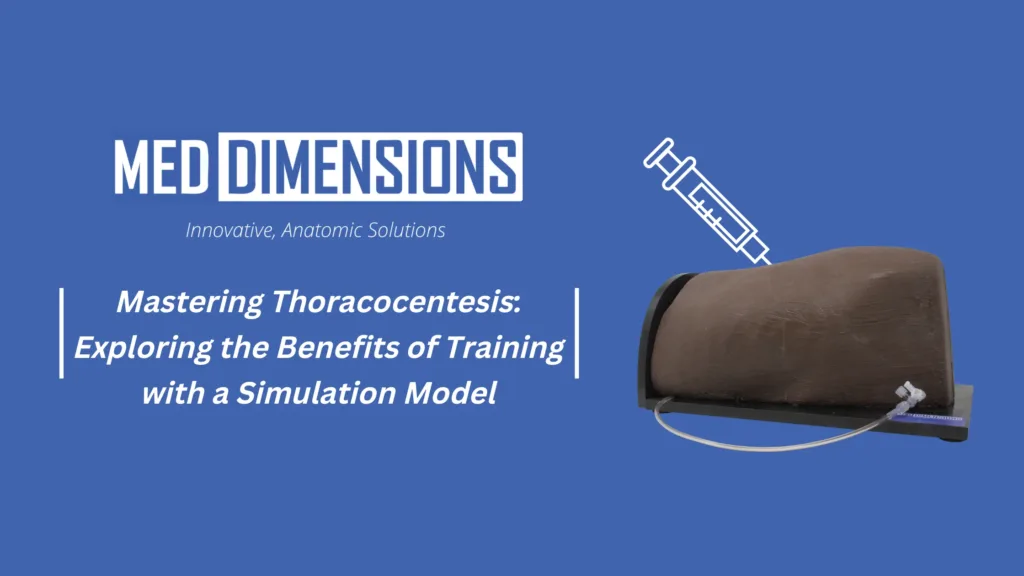Mastering Thoracocentesis: Exploring the Benefits of Training with a Simulation Model

Thoracocentesis, a procedure involving the insertion of a needle into the pleural space to drain fluid or air, is a critical skill for veterinary professionals. It is vital for diagnosing and managing various respiratory conditions and emergencies. Proficiency in thoracocentesis requires knowledge, practice, and hands-on training. That’s where thoracocentesis training models come into play, providing a realistic and safe learning environment for medical practitioners. In this blog post, we will explore the numerous benefits of using thoracocentesis training models to enhance clinical skills and improve patient outcomes.
- Realistic Simulation: One of the primary advantages of thoracocentesis training models is their ability to replicate real-life scenarios accurately. Models closely mimic the anatomy and tactile feedback of real anatomy, providing learners with a realistic experience. By simulating the sensations and challenges encountered during an actual procedure, trainees can develop the necessary skills and gain confidence before performing thoracocentesis on patients.
- Safe Learning Environment: Thoracocentesis is an invasive procedure with inherent risks, including organ injury and infection. Training models offer a safe environment for learners to practice and refine their techniques without jeopardizing patient well-being. Trainees can repeat the procedure multiple times, gradually improving their proficiency while minimizing the potential for harm. This controlled environment fosters a sense of comfort and allows learners to focus on honing their skills.
- Repetitive Practice and Skill Refinement: Mastering thoracocentesis requires practice, repetition, and ongoing skill refinement. Training models provide the opportunity for healthcare professionals to perform the procedure multiple times, facilitating muscle memory development and procedural fluency. By repeating the steps, learners can improve their accuracy, dexterity, and efficiency. Regular practice with training models contributes to better overall performance during actual patient encounters.
- Immediate Feedback and Assessment: Thoracocentesis training models often incorporate feedback mechanisms to provide immediate guidance and assessment. Some models feature built-in sensors that can detect the accuracy of needle placement, depth, and angle. This real-time feedback allows learners to correct errors and refine their technique. By receiving instant guidance, trainees can quickly identify and rectify mistakes, optimizing their learning process and enhancing their overall performance.
- Team Training and Communication: Thoracocentesis is frequently performed in a team setting, requiring effective communication and coordination among healthcare professionals. Training models facilitate collaborative learning by allowing multiple individuals to practice simultaneously. This collaborative environment enables healthcare teams to improve their teamwork, communication, and coordination skills. By training together, teams can enhance their ability to work seamlessly during actual procedures, leading to improved patient safety and outcomes.
- Cost-Effective Education: Traditional thoracocentesis training methods, such as cadaveric training or direct patient encounters, can be costly and messy. Thoracocentesis training models offer a cost-effective alternative, reducing the need for expensive resources, minimizing the consumption of medical supplies, clean up costs, and infection risks to students. Additionally, these models are reusable and durable, providing long-term value for educational institutions, training programs, and healthcare organizations.
Thoracocentesis training models have revolutionized the way healthcare professionals acquire and refine their skills in this crucial procedure. From providing a realistic simulation of real-life scenarios to fostering a safe learning environment, these models offer numerous benefits. Through repetitive practice, skill refinement, and immediate feedback, healthcare practitioners can enhance their competency and confidence in thoracocentesis. Moreover, the anatomical variability of training models enables learners to adapt to diverse patient populations. By leveraging the advantages of thoracocentesis training models, we can improve patient safety, optimize outcomes, and ensure that medical professionals are well-equipped to perform this life-saving procedure.
Visit the Med Dimensions store today to purchase a Canine Thoracocentesis Model for your organization!